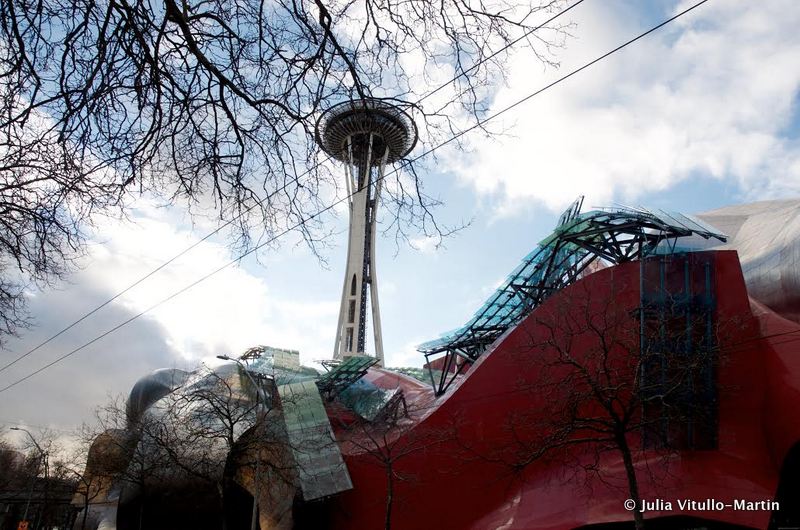 The old future and the new: Seattle’s Space Needle and Experience Music Project Museum
The old future and the new: Seattle’s Space Needle and Experience Music Project Museum
Seattle is its own invention, marching to its own beat, doing things its own way, and over time becoming one of the nation’s most successful cities. Its traditional symbol, the Space Needle, has a certain retro feel, having been created during the 1962 Seattle’s World Fair, which asserted the region’s aerospace dominance (soon to be lost) and looked to an optimistic future, which was decades coming.
Architectural critic Lawrence Cheek finds the Needle endearing: “Sixties kitschy, yes, but the Space Needle remains an icon for a reason. Those long, graceful legs that draw us up and up, matching the city’s ambitions for its fair and its future.”
Today the bright future has arrived. Rivaled only by San Francisco for title of the nation’s most magnificently sited city, Seattle is encircled by fresh and salt water, greenery, and mountains. So dominant is the topography it can hardly be escaped.
“Living in Seattle,” the British writer Jonathan Raban wrote in Granta, “one would have to entomb oneself in the basement to avoid the view. On clear days, the snowy bulk of Mount Rainier, high as the Matterhorn, towers over the city, which squats on the edge of Puget Sound, more than a hundred fathoms deep. The lower slopes of the Cascades to the east and the Olympics to the west are thickly furred with forest.”
Seattle’s extraordinary access to outdoor beauty and sports from its urban core is a prime reason it attracts successful millennials. Some 3,000 of whom earn over $350,000 annually, putting Seattle in the top five cities of rich millennials, says Zillow.
Fast-growing—its population jumped over 25% since 1990 to 668,340 today—Seattle is drawing new business, investment, and residents at high rates, beating out its own wealthy suburbs, and therefore grappling with issues of development and change. A local response has been to welcome public transportation. Not only did Seattle just complete a 3.15-mile extension to its light rail network at a cost of $1.8 billion, it saw the biggest increase in bus riders of any city in the country, making it the second most bus-reliant city after San Francisco.
How R. W. Apple described Seattle in 2000 remains true: It “has become an unmistakably rich, high-tech, high-rise, high-expectation metropolis.”
Should this Nuclear Reactor be Saved?
Take its current preservation battle, which is over, of all things, a tiny Nuclear Reactor Building (renamed More Hall Annex), opened in 1961 on the campus of the University of Washington. It is proposed for landmark designation by co-nominators Docomomo WEWA, Historic Seattle, and the Washington Trust for Historic Preservation on Feb. 12 (it was already listed with the National Register of Historic Places).
The reactor is praised both as an example of Brutalism and as a crucial historic artifact: “Its dynamic form embodies the forward-looking spirit of its time. The architecture is clear and logical, an expression of structure in concrete. Glass fills the space between the structural elements, allowing visual access to the reactor on the level below. The structural assembly showcases concrete in its different roles, especially evident in the cast in place members that support the roof. There is a kinetic energy in the form of the building that speaks of the energy contained within.”
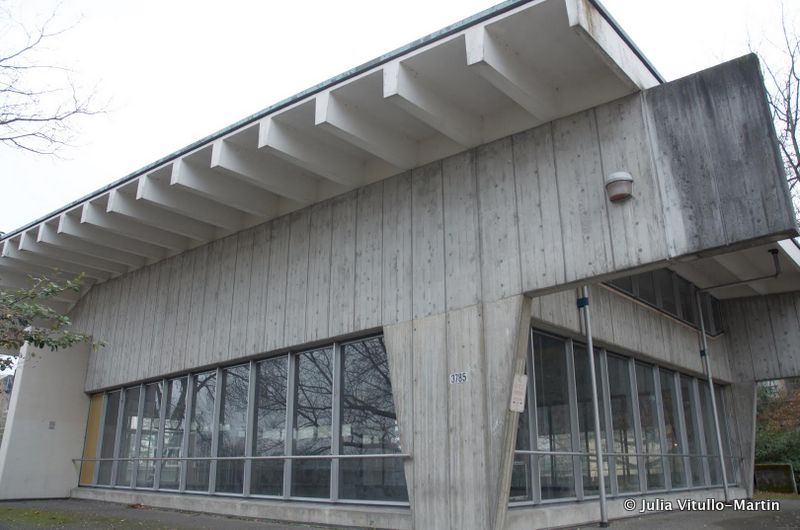 The University of Washington’s Nuclear Reactor Building sits on prime real estate
The University of Washington’s Nuclear Reactor Building sits on prime real estate
It is indeed unique. For one thing, it may well be the cutest nuclear reactor ever built. Alas, it sits on absolutely prime real estate, across from the Paul G. Allen Center for Computer Science and Engineering and in the shadows of Husky Stadium, close to the terminus for Seattle’s newly opened light rail system.
UW, which is eager to demolish the reactor and build on the property, claims that as a state institution of higher learning, it is not subject to local Landmark Preservation Ordinance. Suing to stop the landmarking, it has named the city of Seattle and Docomomo WEWA as defendants.
Preservationists are careful not to criticize the university directly. “They’ve generally been good stewards of the buildings they deemed historic, such as Gothic Revival,” says Eugenia Woo, Director of Preservation Services for Historic Seattle. “But why would you get to pick and choose your landmarks? People think highly of the university and are very loyal to it, but the university is a public institution in a dense urban community. It needs to act like that and not say we can do whatever we want because we’re the university.”
King County Superior Court Judge Suzanne Parisien, who heard oral arguments on April 1, announced on April 14 that the university is not bound by Seattle’s landmarks ordinance because it is not a “person” or “owner,” as defined by the ordinance. This leaves the university free to demolish the reactor.
Noting that UW won on a “technicality,” preservations say they are reviewing their options.
Making Room for More Tech
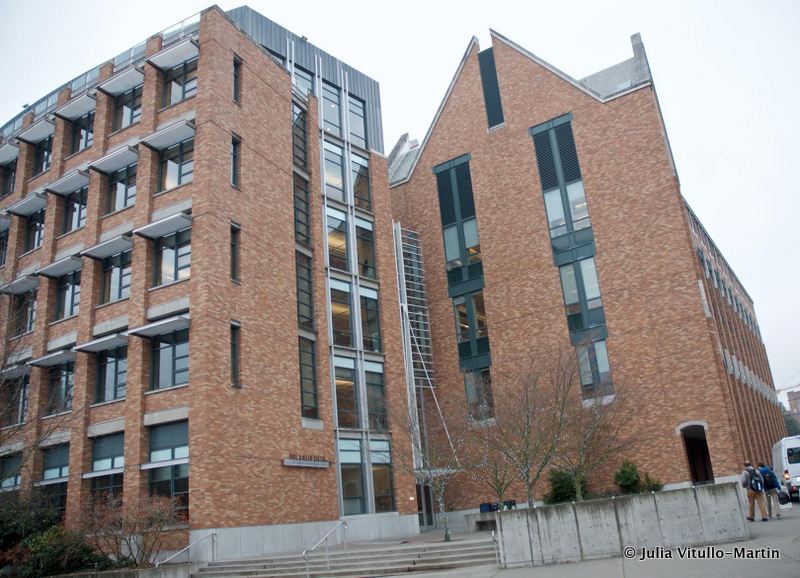 The Paul G. Allen Center for Computer Science & Engineering opened in 2003
The Paul G. Allen Center for Computer Science & Engineering opened in 2003
Since one UW argument for demolishing the reactor building is that they need more space for computer science and engineering, Woo wonders, not unreasonably, why they built such a small computer science center to begin with 15 years ago. “Wasn’t it very short-sighted of the university?” asks Woo, who notes they broke ground in 2001. “This was well before the recession but well after Seattle had become a tech hub. Now they claim a need for a second building.” She’s not a fan of the first building, which she feels “doesn’t quite fit” on the campus.
Yet the Paul G. Allen Center for Computer Science & Engineering, designed by LMN Architects, is rather handsome from the outside and profoundly pleasant inside. Comfortable nooks and small spaces facilitate CSE’s academic objectives of group learning and interaction, and the combination of traditional nerdy low-tech (white boards and magic markers) with high-tech (digital projection and plasma displays) expedites spontaneous discussions and debates.
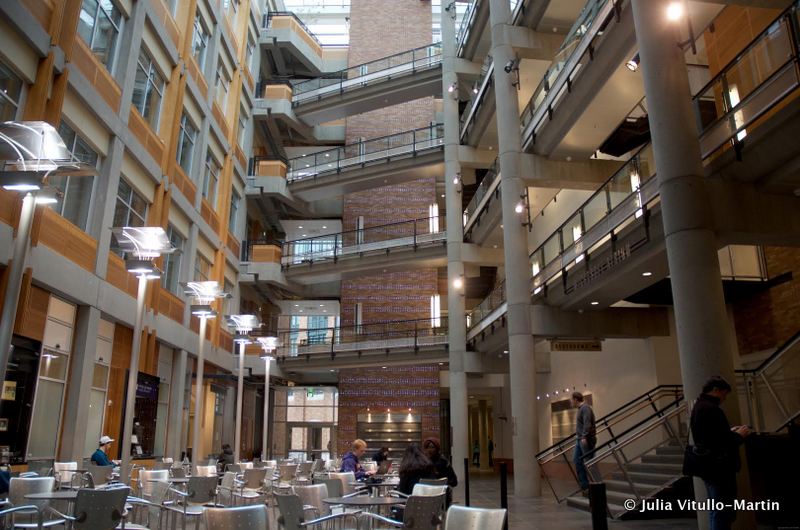 The interior of the Allen Center is elegant and welcoming
The interior of the Allen Center is elegant and welcoming
The interior atrium is reminiscent of soaring urban buildings with huge, light-filled interior courts, such as the Ford Foundation in New York or the Bradbury Building in Los Angeles, both suggesting humane values, generous spirits, and excellent craftsmanship.
Embracing Books
While UW was building its sleek computer center, Seattle’s core saw the construction of the spectacular Central Library, designed by a team led by Dutch architect Rem Koolhaas, financed by the taxpayers of this capital of technology in honor of books in all their traditional glory. At the library’s May 2004 opening, then-Mayor Greg Nickels noted that Seattle residents check out more books per capita than residents of any other city.
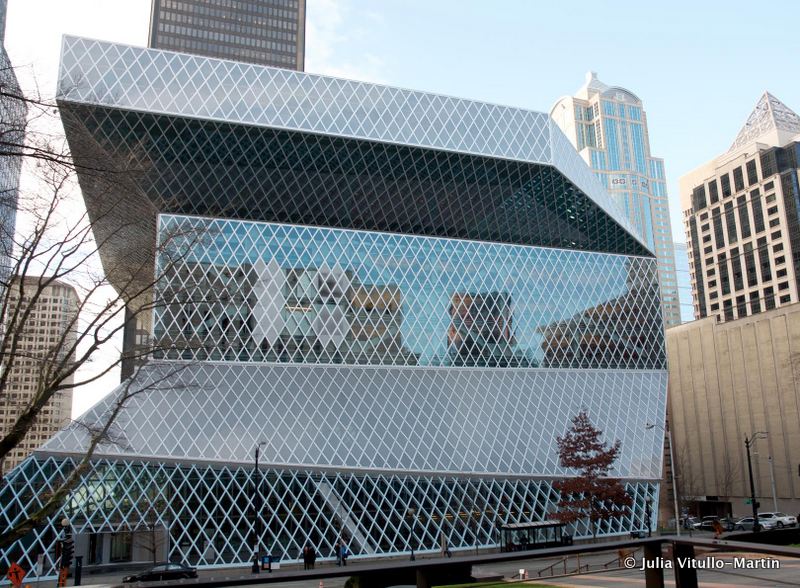 Seattle Central Library
Seattle Central Library
Although not everyone loved it initially, 15 years after it was called a “gigantic fist thrusting out from the downtown soil” and “a 20-story middle digit upraised to the infinite,” the Central Library is regularly packed with users reading, writing, researching. And not just old-style, book-reading users, but a full cross-section of Seattle’s population—all races, ages, and genders, including a few whose stack of possessions suggests they live on the street (Seattle has a large homeless population).
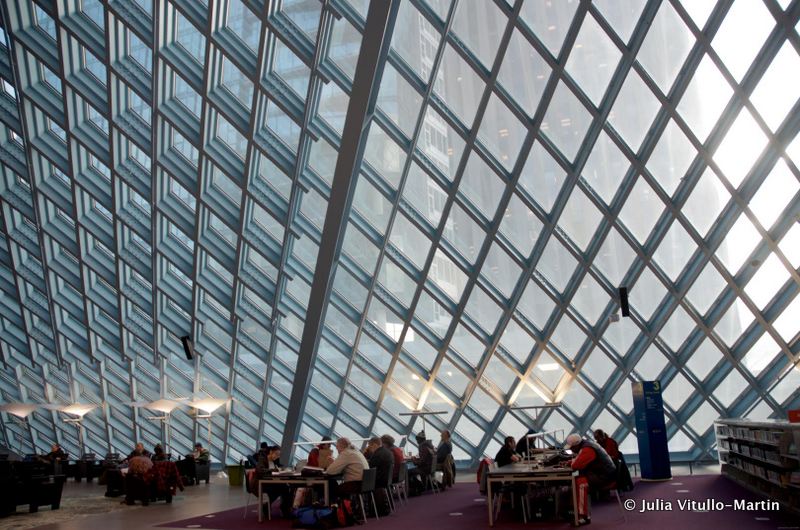 The heavily used interior of the Central Library
The heavily used interior of the Central Library
Architectural critic Witold Rybczynski called the library a hangout for the homeless and young downtowners—given Seattle’s grungy dress code, it can be hard to tell them apart. Yet, everyone looks at home—the tough, no-frills interior neither patronizes nor intimidates, he says. No one is behaving badly or even sleeping. Hanging out yes, but the derelict atmosphere common to so many urban libraries is absent here, despite the high usage, double or triple the 3,000 daily users that had been predicted, says architect Joshua Prince.
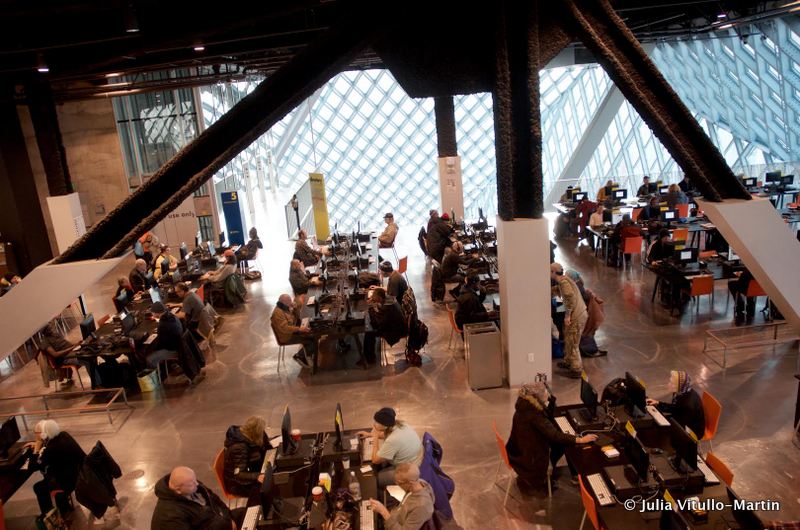 Most chairs in the library’s computer center are taken
Most chairs in the library’s computer center are taken
As hip visual arts writer Jen Graves wrote, in naming the library one of her five favorite American buildings, “This place is alive. It makes you feel you’re in on something, and not something that began recently and will fade away, but the electricity of long-term knowledge-gathering. I am surprised that a library should feel so electric. I am surprised that a building this glamorous should feel so substantial and loving.”
Substantial and loving. Truly remarkable praise for a remarkable building.
Unloved but Still Remarkable
Seattle, which is not a town to kneel and worship the starchitects who come to call, has never really embraced Venturi Scott Brown’s 1991 Seattle Art Museum. Critics have been especially harsh. Rabin, for example, said Seattle was becoming “a junkyard for every famous architect’s worst piece of work,” and that Venturi’s SAM had “absolutely no merit to it at all.” Which is too bad because SAM is a very attractive building that functions well for many of the exhibitions it presents.
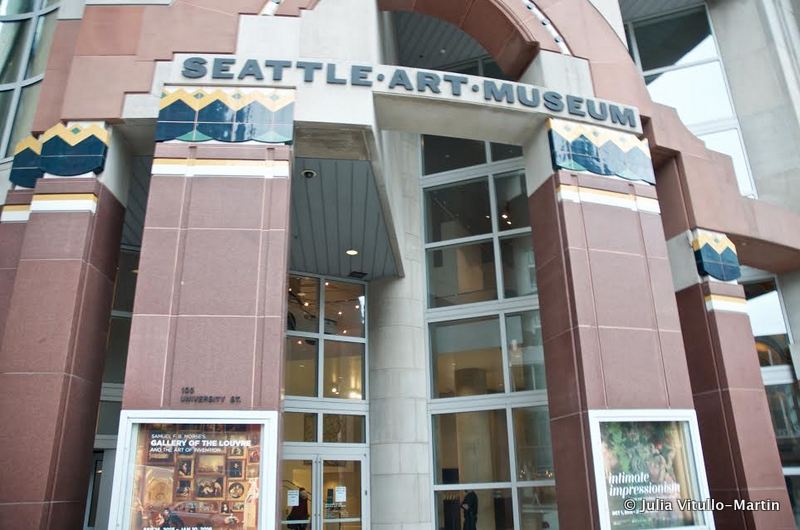 The handsome entrance to the SAM
The handsome entrance to the SAM
Indeed, critic Paul Goldberger liked it so much that he predicted in The New York Times that SAM might do for Venturi “what no building has done for him yet: make him a popular architect.” No such luck. Instead, the building is largely reviled. Which is a shame.
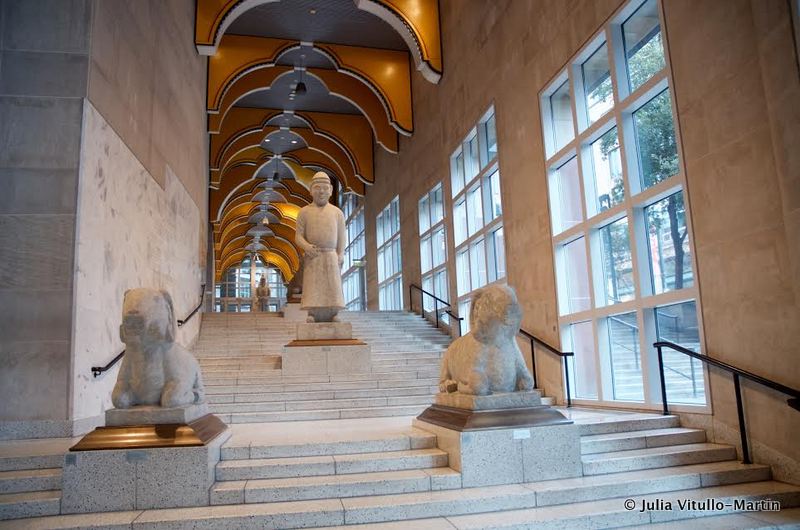 SAM’s Art Ladder staircase
SAM’s Art Ladder staircase
The interior spaces are gracious and open, and the acoustics excellent, making for an wonderful museum experience. Pronounced “dysfunctional,” among other things, by the Seattle Times, SAM was diminished in the mid-1990s, when Washington Mutual erected a 42-story tower next door, integrating itself with SAM’s expanded galleries.
The tower was designed by hot young architect Brad Cloepfil, who later became familiar to New Yorkers (for better or worse) as the architect of the remodel of the Museum of Arts & Design, Edward Durrell Stone’s 1964 lollipop building on Columbus Circle.
Futuristic and Rather Fabulous
Herbert Muschamp, the New York Times’ late architectural critic, loved Koolhaas’s library (“a big rock candy mountain of a building, twinkling in the middle of office buildings”) but disliked SAM (“a rancid piece of work”) and loathed Frank Gehry’s Experience Music Project. He wrote that EMP “looks like something that crawled out of the sea, rolled over and died.” Truly, he was wrong.
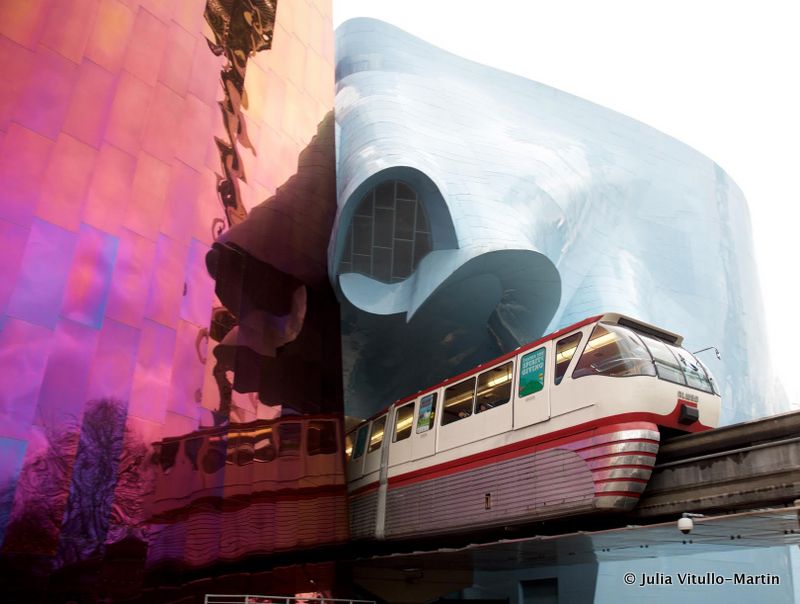 Seattle’s monorail emerging from Frank Gehry’s EMP Museum
Seattle’s monorail emerging from Frank Gehry’s EMP Museum
Commissioned by Paul Allen, EMP is both an interactive music museum and a shrine to Seattle-native Jimi Hendrix, celebrating his immense revolutionary talent and also his roots in blues, jazz, and rock. It offers many public exhibits and educational programs on poplar culture, including workshops and camps for youngsters.
You can see why people would be taken aback by this swoopy, garish, indeed creature-like thing fabricated from aluminum and stainless steel. It’s also set in Seattle Center, a still somewhat bleak cultural park on the edge of downtown. But you can also see what it may become as the city grows up around it and the urban fabric stretches and mends.
Its neighborhood is now seeing aggressive building, including huge towers and corporate parks as behemoths like Amazon and Microsoft decide that the city of Seattle, rather than its suburbs, is where they want to be. As development surrounds it, Frank Gehry’s EMP, with a train plunging in and out of its shimmering steel panels every ten minutes, will be cherished as a welcome gift from a futuristic past.
Next, check out Stunning Global Landmarks Made from Plastic Pen Refills.
Julia Vitullo-Martin is a Senior Fellow at the Regional Plan Association. Get in touch with her @JuliaManhattan






